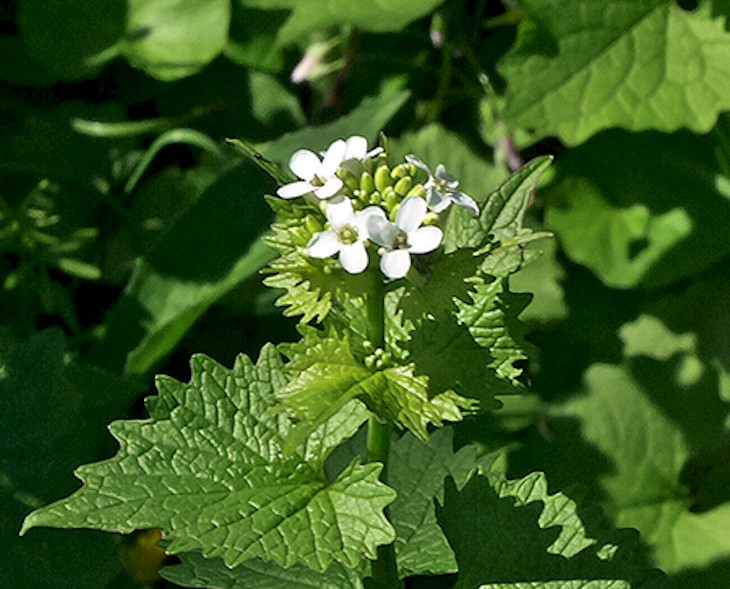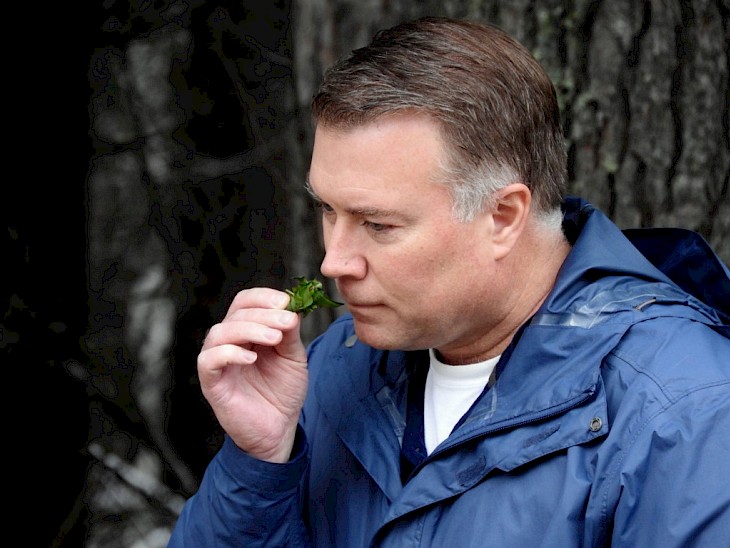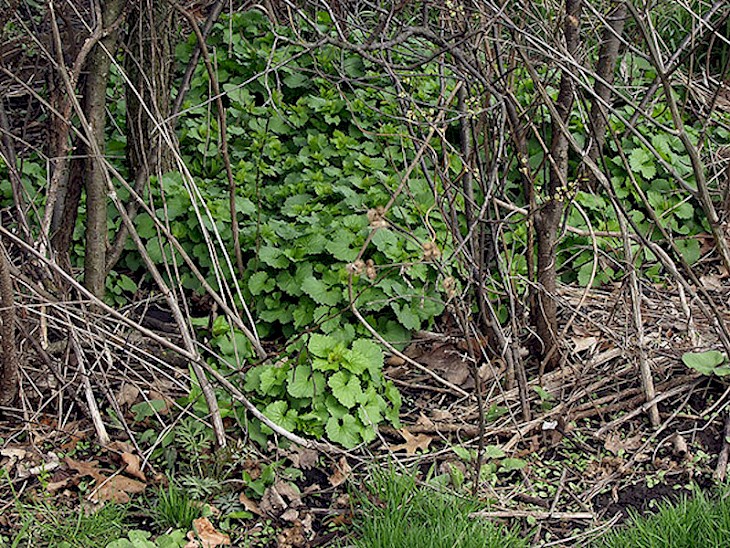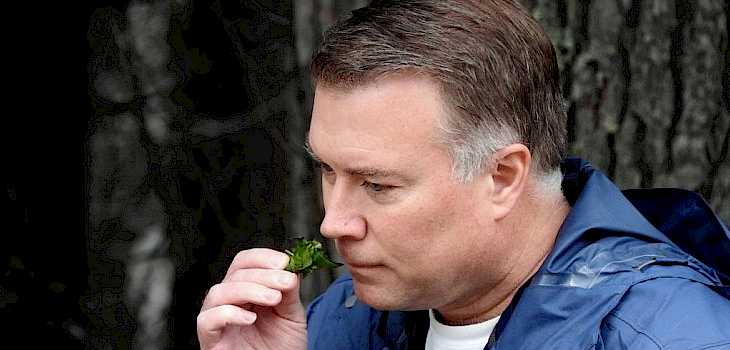It’s hard to go anywhere with me in the spring. We were still within sight of the cars when I spotted my first Dutchman’s breeches leaves and veered off the trail. Fresh raindrops glistened in their clusters of lacey, blue-green foliage, and a few plants hosted spikes of tightly closed buds. Tiny whorls of wood anemone drew me further into the silver maple floodplain forest. Once I was there with my nose down, the jagged leaves of toothwort jumped into view, followed by the mottled leaves of trout lily, and an elegant bloodroot bud, still clasped protectively by its leaf.
The rich soils and brief spring sunshine in this deciduous forest create the perfect habitat for a carpet of my favorite spring wildflowers. The brief appearance of these flowers each year endows them with the value and mystique reserved for things that are both beautiful and rare.
Adam Haecker, Coordinator for the Northwoods Cooperative Weed Management Area (NCWMA), was waiting for me by the trail when I wandered back. He stood resignedly over a whorl of emerald green leaves, much brighter than all the others. We each picked a roundish leaf from the cluster and crushed it under our noses. The spicy scent confirmed my hunch: garlic mustard.

Garlic mustard flowers in its second year. While the leaves are somewhat bitter, at least one wild edible expert suggests eating the flowers. Since you’re going to pull it anyway…Photo courtesy of the NCWMA.
Garlic mustard, Alliaria petiolate, is a non-native species that invades disturbed areas, and also high quality uplands, floodplain forests, and savannas. It’s a biennial, which means that first-year plants grow rosettes of emerald, kidney-shaped leaves with scalloped edges, while second-year plants grow taller stalks with heart-shaped leaves and clusters of small, white, four-petaled flowers. Garlic mustard is pretty, and some people enjoy the flavor (although my one attempt at pesto was bitter), which is why settlers brought it here from Europe in the 1800s.
The problem with it on this continent, though, is that garlic mustard releases anti-fungal chemicals that disrupt the important relationships between native plants and mycorrhizal fungi in the soil. Through sheer quantity, then, it goes on to push out our beautiful—and increasingly rare—spring flowers, and even hinders tree regeneration. The loss of native plants affects insects, herbivores, and more—all the way up the food chain to our friends and loved ones who are spring wildflower enthusiasts.
I grew up pulling garlic mustard’s odorous leaves out of our woods in Northeast Iowa, but hadn’t yet encountered it since moving to northern Wisconsin. We have a lot of acidic soils up here, which aren’t good for either garlic mustard or most spring wildflowers. The downside is that the special, rich woods where I go to see my favorite spring flowers are the ones that are at risk of invasion.

One sure way to make sure you’ve got garlic mustard is to crush and leaf under your nose, as Adam Haecker, Coordinator for the Northwoods Cooperative Weed Management Area (NCWMA) demonstrates here. The pungent odor is unmistakable!
Luckily, garlic mustard is not yet common in the Northwoods. Adam and the NCWMA would like to keep it that way.
The Northwoods Cooperative Weed Management Area is “a collective group of state and federal agencies, municipalities, tribes, nonprofits, community organizations, and individuals who have come together to combat invasive species in Douglas, Bayfield, Ashland, and Iron counties in northern Wisconsin.” I’m impressed by the cross-agency cooperation, and by their accomplishments.

The scalloped, evergreen leaves of garlic mustard become so dense that they can push out almost all native plants in an area. Photo courtesy of the NCWMA.
Garlic mustard was discovered in 2007 on this 75-acre site along the Bad River floodplain in Mellen, near Copper Falls State Park. Its position in the floodplain gives a likely explanation of how the invading seeds arrived. For that same reason, controlling garlic mustard so that it doesn’t spread farther downstream is a high priority for the NCWMA. The land is mostly privately held, but the owner has been supportive of the garlic mustard removal efforts.
Each spring, a group of about 30 natural resource professionals from the NCWMA, plus volunteers, descend on the site and do their best to eradicate the spicy, bright green leaves. Hand pulling is the most common method, but it must be done with care. Plants can re-sprout from broken roots, and the flowers can set seed even in a heap. The workers carefully haul out all plant remains in heavy garbage bags.
Garlic mustard stays green all winter, while native plants are dormant. On the shoulder seasons it’s possible—using extreme caution—to use a glyphosate herbicide on extensive infestations.
No matter which removal method is used on a site, part of the project’s success is a dedicated effort. Each garlic mustard plant can produce more than 100 seeds, and they remain viable in the soil for around seven years. Repeated pulling is essential.
The NCWMA’s efforts are paying off. Plots on this floodplain that were once covered in thick patches of garlic mustard now only sport a few first-year plants. Another site along the Montreal River, near Hurley, WI, is receiving the same treatment and seeing similar, positive results. The keys to success are early detection, landowner involvement, and a dedicated removal effort.
The public can be a big help in thwarting the spread of this pretty little fiend. Hikers can clean the mud off their boots between trails, so as not to transport the seeds. Anyone can volunteer with the NCWMA on fieldwork days. (There’s one coming up on May 9th!) Everyone can keep an eye out for it and other invasive species, and report sightings to Adam at the NCWMA by calling 715-373-6167 or emailing ahaecker@bayfieldcounty.org. If landowners discover garlic mustard on their property, a quick call to the NCWMA, WI Department of Natural resources, Great Lakes Indian Fish & Wildlife Commission, or any other local natural resources agency will initiate a process that includes a site visit, inventory, and plan for removal. The Wisconsin DNR website is an excellent resource for tips on identification, prevention, and control.
While garlic mustard receives a lot of attention, particularly because it’s still rare enough to have a chance at control, the NCWMA also organizes removal efforts for Japanese knotweed, wild parsnip, purple loosestrife, and a whole list of other invasive species. You can find more information on their website: http://www.northwoodscwma.org.
After finding that patch of garlic mustard, Adam and I explored a little farther down the trail. Silver maple trunks arched gracefully above, but my eyes were on the ground. Despite our searching, we couldn’t find another cluster of the invasive plant. What we found—thanks to the hard work of the NCWMA—was a beautiful diversity of spring flowers, just getting ready to bloom.
Special Note: This article was written in partnership with the NCWMA.
Emily's book, Natural Connections: Exploring Northwoods Nature through Science and Your Senses is here! Order your copy at http://cablemuseum.org/natural-connections-book/. Listen to the podcast at www.cablemusum.org!
For 50 years, the Cable Natural History Museum has served to connect you to the Northwoods. Come visit us in Cable, WI! Our new exhibit: "Better Together--Celebrating a Natural Community" will open on May 2!
Last Update: May 05, 2017 10:02 am CDT

















